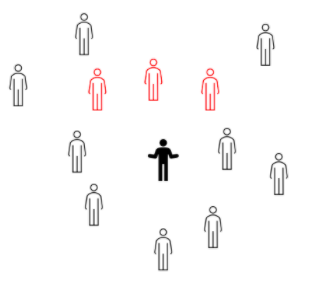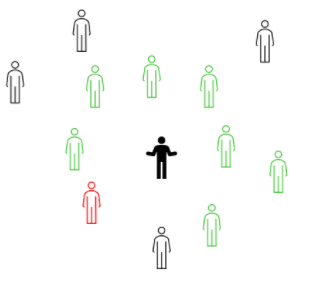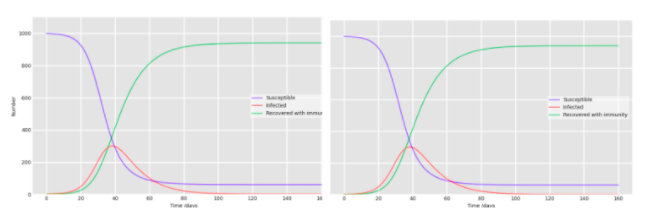1/n. Everything you wanted to know about Herd Immunity, but were afraid to ask.
What is HIT exactly? What’s the relationship with R_t? Will the virus vanish? A thread by @maestro_rayo, @LDjaparidze and @federicolois
What is HIT exactly? What’s the relationship with R_t? Will the virus vanish? A thread by @maestro_rayo, @LDjaparidze and @federicolois
2/n. Some basic concepts first. Unrestricted R_0 or basic reproduction number is “the amount of people that (on average) an infected individual will infect while infectious”, when the vast majority of the population has never been ill before.
3/n You catch a new cold, during the week or so you are ill you’ll infect about 3 persons. Of course you might not infect anybody, but some other will infect 20 at the office. When you take the average everyone has infected roughly 3. Then R_0=3
4/n How is R_0 different from R_t? As time passes, new infected people will meet people that have already caught the cold and have developed immunity to that particular strain. It was recent so immunity takes hold and you are essentially a blocker in the system.
5/n Over time blockers will be found more often, so the effective R_t will decrease as blockers are found with higher probability. If you already infected the entire office, a client coming for a visit with it wont be able to infect anyone.
6/n This is precisely what a SIR (Susceptible-Infected-Recovered) model describes, using math. At the beginning of an epidemic, everybody is susceptible, and as time passes they will change to either the Infected or Recovered state.
7/n. Let’s assume a population of 1000, R_0=3 and infectious time is 10. When people behave normally (no mitigations), you will get the following results from the simulation.
8/n After about 350 people get infected (day 40), the number of "actively" infected (red) starts to decrease. Circa day 50 about 700 are infected and the number of new infections (green) starts to flatten, as well as the susceptibles (blue).
9/n. In this unmitigated scenario, as time goes by, infections go to zero and infections go to about 94% of the population. Herd immunity is achieved when both infected/susceptible curves start to flatten, and that happens when 1-1/R_0 = 67% of the population gets infected.
10/n. Another way to see the HIT value, is the percentage of the population that needs to be infected so that R_t = 1, that is, there is no exponential growth anymore. This is technically called an "endemic steady state".
#Endemic_steady_state">https://en.wikipedia.org/wiki/Mathematical_modelling_of_infectious_disease #Endemic_steady_state">https://en.wikipedia.org/wiki/Math...
#Endemic_steady_state">https://en.wikipedia.org/wiki/Mathematical_modelling_of_infectious_disease #Endemic_steady_state">https://en.wikipedia.org/wiki/Math...
11/n. Will 94% of the population get infected and the virus gone? Not really. Several interesting things happen. Interaction networks (who meets who) in practice are not homogeneous (everybody is not connected to everybody).
12/n. There are loosely connected "pockets" of people interacting (like you at the office), and that causes the virus to have to take several cycles to enter into a cluster. Epidemics cannot exist because blockers do not allow the virus to infect new clusters easily.
13/n Consider the following extreme case. A city is divided by a river (say Budapest) in two sides, say A and B. A pandemic breaks on side A, so you close the only bridge between the two sides of the city in order for the epidemic to never reach the other side (B).
14/n At some point you will need to open the bridge, and even when you do not have an epidemic anymore, there are still pockets of infection. Someone will infect someone in B unless you keep the bridge down indefinitely (New Zealand approach).
15/n The effect is that you will have effectively 2 waves, each one affecting about half of the population.
16/n In the real world, there are millions of "pockets" connected by loosely connected individuals (the friend of your friend that you found at the bar). Even when HIT is reached overall, there will be small ‘outbreaks’. Those ‘random’ fluctuations is what is called endemicity.
17/n. Conditions are not met to have an epidemic, because of the high quantity of blockers. This is what happens every year with the flu. Once upon a time, virus such as Influenza and other coronaviri had huge outbreaks, now they are small.
18/n As population gets renewed, some become susceptible because of lack of reinfectios or other diseases, networks are never fully heterogeneous so the virus never really leaves (see for instance periodic H1N1 localized outbreaks).
19/n We call this a "meta-stable" state or “meta-stability”. You cannot extinguish, nor will you have enough susceptibles available to start an epidemic outbreak, but you have pockets here and there that keeps the virus circulating.
20/n. What is the HIT for Sars-cov-2 then? This depends on various factors. First, there is a range for possible estimated R_0 values (2 to 6), and we know HIT ultimately depends on unrestricted R_0.
21/n. Second, humans have a say into all of this. Behavioral changes motivated by risk aversion will cause some "pockets" to create bubbles and isolate better than others, etc.
22/n And third, it is a matter of discussion whether pre-existent cross-immunities will impact R_t as well. Our take is that the most measurable impact of cross-immunity is the infection fatality rate, but there is no clear answer yet.
23/n. Is it reasonable to assume an unrestricted R_0=3.3 and therefore a 70% HIT? For all uses and purposes yes. Behavioral change will influence R_t to be lower, but at some point you will have to relax and unrestricted makes itself noticeable again.
24/n Also R_0=3.3 is so high for an estimated 5 days cycle virus that higher numbers than that have very small real world implications, besides sparing a few % off the total population or taking a bit longer (but not too much).
25/n To summarize, even if a vaccine will be available tomorrow, the virus will continue spreading at slow speed depending on network heterogeneity as it will become endemic, with probably small seasonal outbreaks like other respiratory viruses.
26/n Second waves are thus unlikely in regions where HIT has probably been reached like Stockholm, Bruxelles and NYC, and very likely in regions that have not been hit hard yet.
PS: If you enjoyed this, you might want to check out this thread on what the Swedish strategy is about and why it can be successfully replicated elsewhere. https://twitter.com/maestro_rayo/status/1299865286376554498">https://twitter.com/maestro_r...

 Read on Twitter
Read on Twitter








